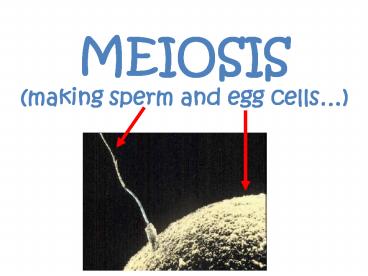MEIOSIS (making sperm and egg cells - PowerPoint PPT Presentation
Title:
MEIOSIS (making sperm and egg cells
Description:
MEIOSIS (making sperm and egg cells ) DNA Passes from Parent to Offspring Two types of reproduction (making more of you): Asexual reproduction a ... – PowerPoint PPT presentation
Number of Views:196
Avg rating:3.0/5.0
Title: MEIOSIS (making sperm and egg cells
1
MEIOSIS(making sperm and egg cells)
2
DNA Passes from Parent to Offspring
- Two types of reproduction (making more of you)
- Asexual reproduction ? a single parent reproduces
by itself - Parent and offspring (child) are genetically
identical - e.g., bacteria, many plants and fungi
http//artfiles.art.com/images/-/Oxford-Scientific
/Green-Hydra-Budding-Photographic-Print-C12940880.
jpeg
http//lifeboat.com/images/bacteria.jpg
3
DNA Passes from Parent to Offspring
- Sexual reproduction ? 2 cells (different parents)
unite to produce the first cell of the new
offspring - parents and offspring are genetically unique
4
Review of Chromosomes
- Chromosome ? condensed DNA, containing all genes
- Normal cells diploid (2n) ? 2 copies of each
chromosome (good idea! backup copy!) - In diploid cells, 1 copy came from each parent
(people 1 from mom, 1 from dad) - Offspring have the same amount of DNA as their
parentsso how can parents only pass on HALF
their genetic material?
5
What is meiosis?
- Meiosis ? special cell division for sexual
reproduction - Produces haploid (1n) cells ? 1 copy of each
chromosome - Haploid cells gametes (sperm/eggs)
- Human gametes
- In ?, meiosis produces (in testes) 4 sperm cells
- In ?, meiosis produces (in ovaries) 1 egg cell
and 3 polar bodies (that later disintegrate)
Mitosis cells divide once Meiosis cells divide
twice
6
Why do meiosis?
Why do ovary and testes cells go through meiosis?
Meiosis is reduction division. It reduces the
chromosome number in the gametes by one half.
From diploid (2n) to haploid (n).
7
Chromosome numbers
In humans, 2n 46 A normal body cell has 46
chromosomes ? 23 came from mom, 23 from dad each
set of 23 from mom is similar to the set of 23
from dad In humans, n 23 A normal gamete has
half the normal chromosome number (n) ? just one
set
8
Chromosome number questions
- If a horse retina cell has 36 chromosomes, how
many chromosomes does a horse sperm cell have? - If n 4 for fruit flies, how many chromosomes
does a wing cell have? - If the 2n number of a pine tree is 86, how many
chromosomes would be found in a pine ovum? - If n 16 for goldfish, how many chromosomes are
in a fin cell?
9
Homologous Pairs
- Homologous pairs ? Pairs of chromosomes with the
same sequence of genes - One is from mom, one from dad
- Genes are in the same order, but
not identical! - e.g., blood type
10
Phases of Meiosis
- Remember mitosis? (I)PMAT
- In meiosis, each phase occurs twice
- Meiosis I Prophase I, Metaphase I, Anaphase I,
Telophase I, Cytokinesis I - Meiosis II Prophase II, Metaphase II, Anaphase
II, and Telophase II, Cytokinesis II
11
Dont freak out I changed the order of the next
slides
12
Meiosis I
- In Prophase I, homologous chromosomes pair up in
a tetrad - same gene sequences, same banding pattern, same
position of centromere - Crossing-over takes place
13
A Sketch of Chromosomes Crossing Over (Prophase I)
- During crossing-over, homologous chromosomes
exchange pieces of DNA - Allows for a reshuffling of genetic material
http//images.google.com/imgres?imgurlhttp//www.
phschool.com/science/biology_place/labbench/lab3/i
mages/crossovr.gifimgrefurlhttp//www.phschool.c
om/science/biology_place/labbench/lab3/crossovr.ht
mlh320w240sz3hlenstart11tbnidGqFKVxw1Z
WYopMtbnh118tbnw89prev/images3Fq3Dcrossin
g2Bover2Bchromosomes26gbv3D226svnum3D1026hl
3Den26safe3Dactive26sa3DG
14
Meiosis I
- Meiosis I results in 2 haploid daughter cells
15
Meiosis II
Meiosis
- Each of the haploid daughter cells from meiosis I
divide again to make 4 haploid cells.
16
Comparing Mitosis and Meiosis
- The processes of mitosis and meiosis are very
similar, but with some important differences
- Meiosis
- Includes 2 cycles of cell division (meiosis I and
meiosis II) - Occurs only in sex cells (gametes)
- Chromosomes cross over in Prophase I
- Results in four genetically different haploid
cells - Metaphase I 2 duplicated chromosomes per spindle
fiber
- Mitosis
- Includes only 1 cycle of cell division
- Occurs in body cells (somatic cells)
- No crossing over of chromosomes
- Results in two genetically identical diploid
cells - Metaphase 1 duplicated chromosome per spindle
fiber
17
(No Transcript)
18
Now, lets look at our flipbooks and compare!!
19
Interphase
- DNA replication occurs
- DNA is in chromatin form (unwound, like spaghetti)
20
Prophase I
- DNA condenses to form chromosomes
- Homologous chromosomes pair up to form tetrads
- Crossing over takes place
21
Metaphase I
- Homologous pairs line up along center of cell
- 1 homologous chromosome and its duplicate are
attached to each spindle fiber
22
Anaphase I
- Homologous pairs separate, move to opposite ends
of the cell
23
Telophase I
- Nuclear membrane reappears
- Spindle fibers disappear
24
Cytokinesis
- Cytoplasm of the two cells separate
- Meiosis I results in 2 haploid cells that are
genetically different
25
Prophase II
- The 2 haploid cells from Meiosis I will divide
again
26
Metaphase II
- Chromosomes (set of sister chromatids) line up
along the center of the cell - 1 sister chromatid attaches to each spindle fiber
27
Anaphase II
- Centromeres split, sister chromatids are pulled
apart
28
Telophase II and Cytokinesis
- Cytoplasm divides, resulting in 4 genetically
different haploid cells






























